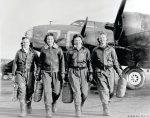
Oregon’s Blanch Osborn
Over the past few months, I’ve had the opportunity to work with a group of incredible volunteers here in Oregon who are working to build a memorial to honor veterans of World War II who served both at home and overseas. Shockingly, Oregon doesn’t have a World War II memorial even though 150,000 Oregonians served in the military and countless others contributed to the war effort by working in factories and shipyards, by planting victory gardens, by making good use of every last scrap. In fact when you think about it, it would be hard to be a citizen of this country—or any country really—and not have some connection to World War II. So, it is odd that Oregon has never built a memorial to honor those who served.
I have been really happy to work on the project for a bunch of reasons—it has statewide importance, it recognizes selfless sacrifice, it’s about time. But temperamentally, I feel edgy about the possibility of glorifying war, and I’m not even that into memorials. I mean, I’ve visited them. I think they’re a good idea generally, but I just haven’t thought that much about what memorials mean to a community, to a country.
One thing that softened me to the potential for memorials is Yusef Komunyakaa’s heart-ripping poem “Facing It” that exquisitely captures a visit—a pilgrimage?—to the Vietnam  Memorial in Washington D.C. Komunyakaa, who earned a Bronze Star for his service in Vietnam, reminds us that wars don’t really end and ennobles the whole idea of creating a place to remember what was sacrificed and what was lost. He doesn’t flinch from injustice or death or fear. And yet, in the end, there is a mother brushing her boy’s hair. Here is the poem in entirety:
Memorial in Washington D.C. Komunyakaa, who earned a Bronze Star for his service in Vietnam, reminds us that wars don’t really end and ennobles the whole idea of creating a place to remember what was sacrificed and what was lost. He doesn’t flinch from injustice or death or fear. And yet, in the end, there is a mother brushing her boy’s hair. Here is the poem in entirety:
“Facing It”
My black face fades,
hiding inside the black granite.
I said I wouldn’t
dammit: No tears.
I’m stone. I’m flesh.
My clouded reflection eyes me
like a bird of prey, the profile of night
slanted against morning. I turn
this way—the stone lets me go.
I turn that way—I’m inside
the Vietnam Veterans Memorial
again, depending on the light
to make a difference.
I go down the 58,022 names
half-expecting to find
my own in letters like smoke.
I touch the name Andrew Johnson;
I see the booby trap’s white flash.
Names shimmer on a woman’s blouse
but when she walks away
the names stay on the wall.
Brushstrokes flash, a red bird’s
wings cutting across my stare.
The sky. A plane in the sky.
A white vet’s image floats
closer to me, then his pale eyes
look through mine. I’m a window.
He’s lost his right arm
inside the stone. In the black mirror
a woman’s trying to erase names:
No, she’s brushing a boy’s hair.
Right, right. Thank you for the reminder, Yusef Komunyakaa. It is our hearts’ work to remember, to truth tell, to not look away. And after having played a small part in this project for the past few months, I actually feel the commitment to that work in a whole new way. Or maybe I feel it rather than just understand it.
Over the past few months, I’ve heard stories of people who enlisted at 16 years old to fight for their country. I’ve heard stories of life at Vanport, where shipyard workers from all over America came together to build the mighty Liberty ships. And then the stories of the African American workers who lost everything when the dyke broke and Vanport flooded. I have heard stories of women making guitars and munitions and men leaving their farms never to return. I have also heard the stories of Americans—Japanese Americans—who were ripped from their homes and sent to internment camps by their own government. Yet, they signed up anyway and served their country with distinction in all branches of the service.
I’ve had the chance to hear those stories because I worked on this project, and I cherish them. But now I want to make sure we don’t lose them. I want to make sure that my daughters and their daughters and the daughters that follow hear these stories. And I want them to be inspired, to believe that we can work together for a common purpose when we need to, when history calls on us. I want them to ask: what can I do?
So I guess that’s it. I’m still not that into war. But I’ve changed my position on memorials. I am into them. I think they’re important and beautiful and heart-wrenching. I think they’re a hearth we can gather around to remember the past and inspire the future. And I’m going to work shoulder to shoulder with all these other Oregonians to make sure this memorial gets built, so we can say: We did it together.
Check it out. Give what you can over at Indiegogo. Tell your friends.
